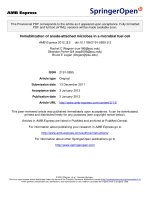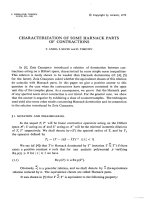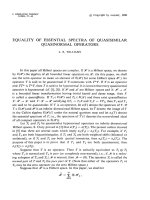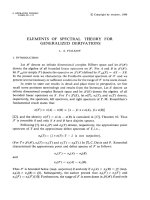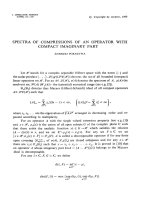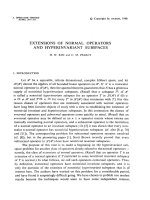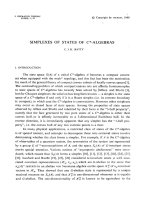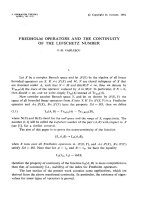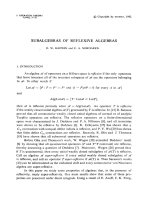Báo cáo toán học: "Enumeration of alternating sign matrices of even size (quasi-)invariant under a quarter-turn rotation" pot
Bạn đang xem bản rút gọn của tài liệu. Xem và tải ngay bản đầy đủ của tài liệu tại đây (197.08 KB, 20 trang )
Enumeration of alternating sign matrices of even size
(quasi-)invariant under a quarter-turn rotation
Jean-Christophe Aval, Philippe Duchon
∗
LaBRI, Universit´e Bordeaux 1, CNRS
351 cours de la Lib´eration,
33405 Talence cedex, FRANCE
{aval,duchon}@labri.fr
Submitted: Oct 16, 2009; Accepted: Mar 19, 2010; Published: Mar 29, 2010
Mathematics Subject Classification: 05A15, 05A99
Abstract
The aim of this work is to enumerate alternating sign matrices (ASM) that are
quasi-invariant under a quarter-turn. The enumeration formula (conjectured by
Duchon) involves, as a product of three terms, the number of unrestricted ASM’s
and the number of half-turn symmetric ASM’s.
1 Introduction
An altern a ting sign matrix is a square matrix with entries in {−1, 0, 1} and such that in
any row and column: the non-zero entries alternate in sign, and their sum is equal to
1. Their enumeration formula was conjectured by Mills, Robbins and R umsey [8], and
proved years later by Zeilberger [16], and almost simultaneously by Kuperberg [6].
Kuperberg’s proof is based on the study of the partition function of a square ice
model whose states a r e in bijection with ASM’s. Kuperberg was able to get an explicit
formula for the partition f unction for some special values of the spectral parameter. To do
this, he used a determinant representation for the partition function, that was obtained
by Izergin [4]. Izergin’s proof is based on the Yang- Ba xter equations, and on recursive
relations discovered by Korepin [5 ].
This method is more flexible than Zeilberger’s original proof and Kuperberg also used
it in [7] to obtain many enumeration or equinumeration results fo r various symmetry
classes of ASM’s, most o f them having been conjectured by Robbins [13]. Among these
results can be found the following remarkable one.
∗
Both authors are supported by the ANR project MARS (BLAN06-2 0193)
the electronic journal of combinatorics 17 (2010), #R51 1
Theorem 1 (Kuperberg). The number A
QT
(4N) of ASM’s of size 4N invariant under a
quarter-turn (QTASM’s) is related to the number A(N) of (unrestricted) ASM’s of size N
and to the number A
HT
(2N) of ASM’s of size 2N invariant under a half-turn (HTASM’s)
by the formula:
A
QT
(4N) = A
HT
(2N)A(N)
2
. (1)
More recently, Razumov and Stroganov [12] applied Kuperberg’s stra t egy to settle the
following result relative to QTASM’s of odd size, also conjectured by Robbins [13] .
Theorem 2 (Razumov, Strog anov). The numbers of QTASM’s of odd size are given by
the foll owing formulas, where A
HT
(2N + 1) is the number of HTASM’s of size 2N + 1:
A
QT
(4N −1) = A
HT
(2N − 1)A(N)
2
(2)
A
QT
(4N + 1) = A
HT
(2N + 1)A(N)
2
. (3)
It is easy to observe (and will be proved in Section 2) tha t the set of QTASM’s of size
4N + 2 is empty. But, by slightly relaxing the symmetry condition at the center of the
matrix, Duchon introduced in [3, 2] the notio n of ASM’s quasi-invariant under a quarter
turn (the definition will be given in Section 2) whose class is non-empty in size 4N + 2.
Moreover, he conjectured for these qQTASM’s an enumeration formula that perfectly
completes the three previous enumerat io n result s on QTASM. It is the aim of this paper
to establish this formula.
Theorem 3 The number A
QT
(4N + 2) of qQTASM of size 4N + 2 is given by:
A
QT
(4N + 2) = A
HT
(2N + 1)A(N)A(N + 1). (4)
This paper is organized as follows: in Section 2, we define qQTASM’s; in Section 3,
we recall the definitions of square ice models, precise the parameters and the partition
functions that we shall study, and give the formula corresponding to equation (4) at
the level of partition functions; Section 4 is devoted to the proofs; open questions are
presented in Section 5.
2 ASM’s quasi-i nvariant under a qu arter-turn
The class of ASM’s invariant under a rotation by a quarter-turn (QTASM) is non-empty
in size 4N − 1, 4N, and 4N + 1. But t his is not the case in size 4N + 2.
Lemma 4 There is no QTASM of size 4N + 2.
Proof. Let us suppose that M is a QTASM of even size 2L. Now we use the fact that the
size of an ASM is given by the sum of its entries, and the symmetry of M to write:
2L =
1≤i,j≤2L
M
i,j
= 4 ×
1≤i,j≤L
M
i,j
(5)
the electronic journal of combinatorics 17 (2010), #R51 2
which implies that the size of M has to be a multiple of 4.
Duchon introduced in [3, 2] a notion of ASM’s quasi-invariant under a quarter-turn,
by slightly relaxing the symmetry condition at the center of the matrix. The definition is
more simple when considering the height matrix associated to the ASM, but can also be
given directly.
Definition 5 An ASM M of size 4N +2 is said to be quasi-invariant under a quarter-turn
(qQTASM) if its entries satisfy the quarter-turn symmetry
M
4N+3−j,4N +3−i
= M
i,j
(6)
except for the four central entries (M
2N+1,2N+1
, M
2N+1,2N+2
, M
2N+2,2N+1
, M
2N+2,2N+2
) that
have to be ei ther (0, −1, −1, 0) or (1, 0, 0, 1).
We give below two examples of qQTASM’s of size 6, with the two possible patterns at
the center.
0 0 0 1 0 0
0 0 1 0 0 0
1 0 0 −1 1 0
0 1 −1 0 0 1
0 0 0 1 0 0
0 0 1 0 0 0
0 0 1 0 0 0
0 1 −1 0 1 0
0 0 1 0 −1 1
1 −1 0 1 0 0
0 1 0 −1 1 0
0 0 0 1 0 0
In the next section, we associate square ice models to ASM’s with various types o f
symmetry.
3 Square ice mode l s and partition func tions
3.1 Notations
Using Kuperberg’s method we introduce square ice models associated to ASM’s, HTASM’s
and (q)QTASM’s. We recall here the main definitions and r efer to [7 ] for details and many
examples.
Let a ∈ C be a global parameter. For any complex number x different from zero, we
denote x = 1/x, and we define:
σ(x) = x − x. (7)
Let G denote some graph
1
where every vertex has degree 1, 2 or 4, wit h a fixed
orientation attached to each edge incident to a vertex of degree 1. An ice state of G is
an orientation of the remaining edges such that every tetravalent vertex has exa ctly two
incoming and two outgoing edges, and each vertex of degree 2 has either two incoming or
two outgoing edges.
1
Actually, our “graphs” are planar graphs together with a plane embedding.
the electronic journal of combinatorics 17 (2010), #R51 3
A parameter x = 0 is assigned to one of the angles between consecutive incident edges
around each tetravalent vertex o f the graph G. Then this vertex gets a weight, which
depends on the orientation of incident edg es, as shown on Figure 1; the reader can check
that weights a r e unchanged if one of the angle parameters is moved an adjacent angle of
the same vertex, and simultaneously replaced by its inverse.
x
=
σ(a
2
) σ(a
2
)
σ(ax) σ(ax) σ(ax) σ(ax)
Figure 1: The 6 possible orientations and their associated weights
It is sometimes easier to assign parameters, not to each vertex of the graph, but to
the lines that compose the graph. In this case, the weight of a vertex is defined as:
x
y
=
xy
When this convention is used, a parameter explicitly written at a vertex replaces the
quotient of the parameters of the lines.
We will put a dotted line to indicate that the parameter of a line is different on the
two sides of the dotted line.
Vertices with degree 2 do not get a parameter (they are only used to force the two
incident edges to have opposite orienta t io ns), and get weight 1.
=
1 1
The partition functio n of a given ice graph is then defined as the sum, over all its ice
states, of the products of weights of all vertices.
To simplify notations, we will denote by X
N
the vector of variables (x
1
, . . . , x
N
). We
use the notation X\x to denote the vector X without the variable x.
3.2 Partition functions for classes of ASM’s
We give in Figures 3, 4, and 5 the ice models corresponding to the classes of ASM’s that
we shall study, a nd their partition functions. The bijection between (unrestr icted) ASM’s
and states of the square ice model with “domain wall boundary” is now well-known (cf.
[7]), and the bijections for the other symmetry classes may be easily checked in the same
way. The correspondence between orientations of the ice model and entries of ASM’s is
given in Figure 2.
The reader may notice that the grid used to define Z
QT
(4N) sligthly differs f r om the
one used by Kuperberg (the central vertices are treated in a different manner, and the
the electronic journal of combinatorics 17 (2010), #R51 4
1 −1 0 0 0 0
Figure 2: The correspondence between ice states and ASM’s
Z(N; x
1
, . . . , x
N
, x
N+1
, . . . , x
2N
) =
x
1
x
2
x
N
x
N+1
x
2N
Figure 3: Partition function for ASM’s of size N
Z
HT
(2N; x
1
, . . . , x
N−1
, x
N
, . . . , x
2N−1
, x, y) =
x
1
x
N−1
y
x
x
N
x
2N−1
x
1
x
2
x
N
x
x
N+1
x
2N
y
= Z
HT
(2N + 1; x
1
, . . . , x
N
, x
N+1
, . . . , x
2N
, x, y)
Figure 4: Partition functions for HTASM’s
the electronic journal of combinatorics 17 (2010), #R51 5
Z
QT
(4N; x
1
, . . . , x
2N−1
, x, y) =
x
1
x
2
x
2N−1
x
y
x
1
x
2
x
2N
x
y
= Z
QT
(4N + 2; x
1
, . . . , x
2N
, x, y)
Figure 5: Partition functions for (q)QTASM of even size
line xy only carries a single para meter x
2N
in Kuperberg’s model). Z
HT
(2N) also appears
in Kuperberg’s paper [7] with a single parameter on the xy line; Z
HT
(2N + 1 ) appears
identically in Razumov and Stroganov’s paper [11] (where a different convention is used
for the weights of vertices).
With these notations, Theorem 3 will be a consequence of the following one which
addresses the concerned partition functions.
Theorem 6 Wh en a = ω
6
= exp(iπ/3), one has for N ≥ 1:
σ(a)Z
QT
(4N; X
2N−1
, x, y) = Z
HT
(2N; X
2N−1
, x, y)Z(N; X
2N−1
, x)Z(N; X
2N−1
, y) (8)
and
σ(a)Z
QT
(4N + 2; X
2N
, x, y) = Z
HT
(2N + 1; X
2N
, x, y)Z(N; X
2N
)Z(N +1; X
2N
, x, y). (9)
Equation (9) is new; Equation (8) is due to Kuperberg [7] for the case x = y. To see
that Theorem 6 implies Theorem 3 (and Theorem 1), we just have to observe that when
a = ω
6
and all the variables are set to 1, then the weight a t each vertex is σ(a) = σ(a
2
) =
i
√
3 thus the partition function reduces (up to multiplication by σ(a)
number of vertices
) to
the number of states. This is summarized in the following proposition, where 1 denotes
the vector of all variables set to 1.
the electronic journal of combinatorics 17 (2010), #R51 6
Proposition 1 For a = e
iπ/3
, we have:
Z(N; 1) = (i
√
3)
N
2
A(N) (10)
Z
HT
(2N; 1) = (−1)
N
3
N
2
A
HT
(2N) (11)
Z
HT
(2N + 1; 1) = 3
N
2
+N
A
HT
(2N + 1) (12)
Z
QT
(4N; 1) = −i.3
2N
2
−1/2
A
QT
(4N) (13)
Z
QT
(4N + 2; 1) = 3
2N
2
+2N
A
QT
(4N + 2). (14)
4 Proofs
To prove Theorem 6, the method, inspired from [7], is to identif y both sides of equations
(8) and (9) as Laurent polynomials, and to produce as many specializations of t he variables
that verify the equalities, as needed to imply these equations in full generality.
In previous wo r ks [7, 12], t he final point in proofs is the evaluation of determinants
or Pfaffians; in our proof of Theorem 6, we are able to avoid this computation by using
symmetry properties.
4.1 Laurent polynomials
Since the weight of any vertex is a Laurent polynomial in the variables x
i
, x and y,
the partition functions are Laurent p olynomials in these variables. Moreover they are
centered Laurent polynomials, i.e. their lowest degree is the negative of their highest
degree (called the half-width of the polynomial). In order to divide by two the number
of no n-zero coefficients (hence the number of required specializations) in x, we shall deal
with Laurent polynomials of given parity in this variable. To do so, we gro up together
the states with a given orientation (indicated as subscripts in the following notations) at
the edge where the parameters x and y meet.
So let us consider the partition functions:
• Z
QT
(4N; X
2N−1
, x, y) and Z
QT
(4N; X
2N−1
, x, y), respectively odd and even parts of
Z
QT
(4N; X
2N−1
, x, y) in x;
• Z
QT
(4N + 2; X
2N
, x, y) and Z
QT
(4N +2; X
2N
, x, y), respectively odd and even parts
of Z
QT
(4N + 2; X
2N
, x, y)in x;
• Z
HT
(2N; X
2N−1
, x, y) and Z
HT
(2N; X
2N−1
, x, y), respectively parts with the parity
of N and of N − 1 of Z
HT
(2N; X
2N−1
, x, y) in x;
• and Z
HT
(2N + 1; X
2N
, x, y) and Z
HT
(2N + 1; X
2N
, x, y), respectively parts with the
parity of N −1 and of N of Z
HT
(2N + 1; X
2N
, x, y) in x.
the electronic journal of combinatorics 17 (2010), #R51 7
With these notations, Equations (8) and (9) are equivalent to the fo llowing:
σ(a)Z
QT
(4N; X
2N−1
, x, y)=Z
HT
(2N; X
2N−1
, x, y)Z(N; X
2N−1
, x)Z(N; X
2N−1
, y), (15)
σ(a)Z
QT
(4N; X
2N−1
, x, y)=Z
HT
(2N; X
2N−1
, x, y)Z(N; X
2N−1
, x)Z(N; X
2N−1
, y), (16)
σ(a)Z
QT
(4N + 2; X
2N
, x, y)=Z
HT
(2N + 1; X
2N
, x, y)Z(N + 1; X
2N
, x, y)Z(N; X
2N
), (17)
σ(a)Z
QT
(4N + 2; X
2N
, x, y)=Z
HT
(2N + 1; X
2N
, x, y)Z(N + 1; X
2N
, x, y)Z(N; X
2N
). (18)
Lemma 7 Both left-hand side and right-hand side of Equations (15-18) are centered Lau-
rent polynomials in the variable x, odd or e v en, of respective half-wi dths 2N −1, 2N −2,
2N, and 2N −1. Thus, to prove each of these identities it is sufficient to exhibit special-
izations of x for which the equality is true, and in number strictly exceeding the half-width.
Proof. To compute the half-width of these partition functions, we have to count the
number of vertices in the ice models, and take note that non-zero entries of the ASM
(i.e. the first two o r ientations of Figure 1) give constant weight σ(a
2
). Also, a line whose
orientation changes (respectively does not change) between endpoints must have an odd
(resp ectively even) number of these ±1 entries.
We give t he details for Equation (15):
• The term Z(N; X
2N−1
, y) is a constant in x.
• For Z(N; X
2N−1
, x), the variable x appears in the parameter of the N vertices of the
rightmost vertical line. On this line, for each state of the model, exactly one vertex
gives a constant weight σ(a
2
), the other N − 1 contribute for 1 to the half-width.
• For Z
HT
(2N; X
2N−1
, x, y), we have N vertices on the line that carries the parameter
x, and an even number of them gives a constant weight.
• For Z
QT
(4N; X
2N−1
, x, y), we have in the same manner 2N −1 vertices that carries
the parameter x, and an even number of them gives a constant weight σ(a
2
).
This proves that both the left-hand side and the right-hand side of equation (15) are odd
Laurent plynomial of half-width 2N −1. The assertions on Equations (16-18) are treat ed
in the same way.
4.2 Symmetries
To produce many specializations from one, we shall use symmetry properties of the par-
tition functions. The crucial tool to prove this is the Yang-Baxter equation that we recall
below.
Lemma 8 [Yang-Baxter equation] If xyz = a, then
x
y
z
=
x
y
z
. (19)
the electronic journal of combinatorics 17 (2010), #R51 8
The fo llowing lemma gives a (now classical) example of use of the Yang-Baxter equa-
tion.
Lemma 9
x
y
. . .
=
y
x
. . .
. (20)
Proof. We multiply the left-hand side by σ(az), with z = axy. We get
σ(az)
x
y
. . .
=
y
x
z
. . .
=
y
x
z
. . .
=
y
x
. . .
z
=
y
x
. . .
z
=
y
x
. . .
σ(az)
The same method, together with the easy transformation
z
=
σ(az) + σ(a
2
)
+
(21)
gives the following lemma.
Lemma 10
x
y
. . .
=
σ(a
2
) + σ(xy)
σ(a
2
yx)
y
x
. . .
(22)
x
y
. . .
=
σ(xy)
σ(a
2
yx)
y
x
. . .
+
σ(a
2
)
σ(a
2
yx)
y
x
. . .
(23)
x
y
. . .
=
σ(xy)
σ(a
2
yx)
y
x
. . .
+
σ(a
2
)
σ(a
2
yx)
y
x
. . .
(24)
We use Lemmas 9 and 10 to obtain symmetry properties of the partition functions,
that we summarize below, where m denotes either 2N or 2N + 1.
Lemma 11 The functions Z(N; X
2N
) and Z
HT
(2N + 1; X
2N
, x, y) are symmetric sep-
arately in the two sets of variables {x
i
, i ≤ N} and {x
i
, i ≥ N + 1}, the function
Z
HT
(2N; X
2N−1
, x, y) is symmetric separately in the two sets of varia bles {x
i
, i ≤ N −1}
and {x
i
, i ≥ N}, and the functions Z
QT
(2m; X
N−1
, x, y) are symmetric in their variabl es
x
i
.
the electronic journal of combinatorics 17 (2010), #R51 9
Moreover, Z
QT
(4N + 2; . . . ) is symmetric in its variables x and y, and we have a
pseudo-symmetry for Z
QT
(4N; . . . ) a nd Z
HT
(2N; . . . ):
Z
QT
(4N; X
2N−1
, x, y) =
σ(a
2
) + σ(xy)
σ(a
2
yx)
Z
QT
(4N; X
2N−1
, y, x), (25)
Z
HT
(2N; X
2N−1
, x, y) =
σ(a
2
) + σ(xy)
σ(a
2
yx)
Z
HT
(2N; X
2N−1
, y, x). (26)
Proof.
For Z(N; . . . ), Z
HT
(m; . . . ) and Z
QT
(2m; . . . ), the symmetry in two “consecutive”
variables x
i
and x
i+1
is a direct consequence of Lemma 9.
For the (pseudo-)symmet ry of Z
QT
(2m; . . . ), we use the easy observations:
=
and
=
(27)
which gives us the following modification of the grid in size 4N + 2:
Z
QT
(4N + 2; X
2N
, x, y) =
x
y
=
y x
the electronic journal of combinatorics 17 (2010), #R51 10
and in size 4N:
Z
QT
(4N; X
2N−1
, x, y) =
x
y
=
y x
Now for Z
QT
(4N + 2; . . . ), Lemma 9 allow us to exchange the lines of parameters x
and y, which proves the symmetry. for Z
QT
(4N; . . . ), we apply Lemma 10 to conclude.
The last assertion concerns Z
HT
(2N; . . . ), and Lemma 10 g ives directly (26) without
any modification of the graph.
Remark 12 It should be clear, but is useful to note, that we have analogous properties
for the even and odd parts of the partition functions.
The next (and last) symmetry property, proved by Stroganov [14], appears when the
parameter a takes the special value ω
6
= exp(iπ/3).
Lemma 13 When a = ω
6
= exp(iπ/3), the partition function Z(N; X
2N
) is symmetric
in all its variables.
Stroganov proved this surprising symmetry property by a study of Izergin-Korepin
determinant. A proof only involving Yang-Baxter equation has recently been given in [1].
4.3 Specializations, recurrences
The aim of this sect io n is to give the value of the partition functions in some specializations
of t he variable x or y. The first result is due to Kuperberg; the others are very similar.
Lemma 14 [specialization of Z; Kuperberg] If we denote
A(x
N+1
, X
2N
\{x
1
, x
N+1
}) =
2≤k ≤N
σ(ax
k
x
N+1
)
N+1≤k≤2N
σ(a
2
x
N+1
x
k
),
A(x
N+1
, X
2N
\{x
1
, x
N+1
}) =
2≤k ≤N
σ(ax
N+1
x
k
)
N+1≤k≤2N
σ(a
2
x
k
x
N+1
),
the electronic journal of combinatorics 17 (2010), #R51 11
then we have:
Z(N; ax
N+1
, X
2N
\x
1
) = A(x
N+1
, X
2N
\{x
1
, x
N+1
})Z(N −1; X
2N
\{x
1
, x
N+1
}), (28)
Z(N; ax
N+1
, X
2N
\x
1
) = A(x
N+1
, X
2N
\{x
1
, x
N+1
})Z(N −1; X
2N
\{x
1
, x
N+1
}). (29)
Proof. We recall the method to prove equation (28 ) . We consider the crossing of the lines
of pa rameter x
1
and x
N+1
which could of the following two types:
σ(a
2
)
σ(ax)
We observe that when x
1
= ¯ax
N+1
, the parameter of t he vertex at the crossing o f
the two lines of parameter x
1
and x
N+1
is x = x
1
¯x
N+1
= ¯a. Thus the weight of this
vertex is σ(a¯a) = σ(1) = 0 in the second orientation on the figure above. This forces
the orientation of this vertex to be the first described in this figure. But this orientation
implies the orientation of all vertices in the row x
1
and in the column x
N+1
, as shown
on Figure 6. The non-fixed part gives the partition function Z in size N − 1, without
parameters x
1
and x
N+1
, and the weights of the fixed part gives the factor A(. . . ).
x
1
= ax
N+1
x
N
x
2
x
N+1
x
2N
x
1
= ax
1
x
N
x
2
x
N+1
x
2N
Figure 6: Fixed edges for (28) on the left and (2 9) on the right
The case of (29) is similar, after using Lemma 11 to put the line x
N+1
at the top of
the grid, as shown on Figure 6.
We will need the following application of the Yang-Baxter equation, which allows,
under certain condition, a line with a change of parameter to go through a grid.
Lemma 15
x
ax
=
x
ax
(30)
the electronic journal of combinatorics 17 (2010), #R51 12
Proof. We iteratively apply Lemma 8 o n the rows, and row by row:
x
ax
=
x
x
ax
=
x
x
ax
=
x
x
ax
=
ax
x
.
Lemma 16 [specialization of Z
HT
] If we denote
A
1
H
(x
1
, X
2N
\x
1
) =
1≤k ≤N
σ(a
2
x
1
x
k
)
N+1≤k≤2N
σ(ax
k
x
1
),
A
1
H
(x
1
, X
2N
\x
1
) =
1≤k ≤N
σ(a
2
x
k
x
1
)
N+1≤k≤2N
σ(ax
1
x
k
),
A
0
H
(x
N
, X
2N−1
\x
N
) =
1≤k ≤N−1
σ(ax
k
x
N
)
N≤k≤2N−1
σ(a
2
x
N
x
k
),
A
0
H
(x
N
, X
2N−1
\x
N
) =
1≤k ≤N−1
σ(ax
N
x
k
)
N≤k≤2N−1
σ(a
2
x
k
x
N
),
then for ⋆ = , , , and = , , , respectively, we have
Z
⋆
HT
(2N + 1; X
2N
, x, ax
1
)=A
1
H
(x
1
, X
2N
\x
1
)Z
HT
(2N; X
2N
\x
1
, x
1
, x), (31)
Z
HT
(2N + 1; X
2N
, x, ax
1
)=A
1
H
(x
1
, X
2N
\x
1
)Z
⋆
HT
(2N; X
2N
\x
1
, x, x
1
), (32)
Z
⋆
HT
(2N; X
2N−1
, x, ax
N
)=σ(axx
N
)A
0
H
(x
N
, X
2N−1
\x
N
)Z
HT
(2N − 1; X
2N−1
\x
N
, x, x
N
),
(33)
Z
HT
(2N; X
2N−1
, ax
N
, y)=σ(ax
N
y)A
0
H
(x
N
, X
2N−1
\x
N
)Z
⋆
HT
(2N − 1; X
2N−1
\x
N
, y, x
N
).
(34)
Proof.
The proof is similar to the previous one, with the difference that before looking at
fixed edges, we need to multiply the partition function by a given factor; we interpret this
operation by a modification of the graph of the ice model, and apply Lemma 15. It turns
out that in each case, the additional factors are exactly cancelled by the weights of fixed
vertices.
the electronic journal of combinatorics 17 (2010), #R51 13
To prove (31), we multiply the left-hand side by
N+1≤k≤2N
σ(a
2
x
k
y),
which is equivalent to adding to the line of parameter y a new line ay just below the grid;
Lemma 15 transforms the graph of Figure 7(a) into the graph of Figure 7(b). When we
put y = ax
1
, we get the indicated fixed edges, which gives as partition function
N+1≤k≤2N
σ
2
(ax
k
x
1
)
1≤k ≤N
σ(a
2
x
1
x
k
)Z
HT
(2N; X
2N
\x
1
, x
1
, x).
x
1
x
N
x
ay
x
N+1
x
2N
y
(a)
x
1
x
N
x
y x
N+1
x
2N
ay = x
1
(b)
Figure 7: Proof of (31)
Since a
2
x
k
y = ax
k
x
1
, the equation simplifies. To conclude, we observe that if we start
with an edge going out from the crossing x/x
2N
(function Z
HT
) we g et at the end the
same orientation (function Z
HT
).
The proo f of equations (32-34) follows the same path. We give in Figure 8 the modi-
fications performed to the graph for the proof of (32).
Lemma 17 [specialization of Z
QT
] If we denote
A
Q
(x
1
, X
m−1
\x
1
) =
1≤k ≤m−1
σ(a
2
x
k
x
1
)σ(ax
1
x
k
),
A
Q
(x
1
; X
m−1
\x
1
) =
1≤k ≤m−1
σ(a
2
x
1
x
k
)σ(ax
k
x
1
),
then for ⋆ = , , , and = , , , respectively, we have:
Z
⋆
QT
(2m; X
m−1
, ax
1
, y) = σ(ax
1
y)A
Q
(x
1
, X
m−1
)Z
QT
(2m −2; X
m−1
\x
1
, y, x
1
), (35)
Z
QT
(2m; X
m−1
, x, ax
1
) = σ(axx
1
)A
Q
(x
1
; X
m−1
\x
1
)Z
⋆
QT
(2m −2; X
m−1
\x
1
, x
1
, x). (36)
the electronic journal of combinatorics 17 (2010), #R51 14
x
1
x
N
x
ay
x
N+1
x
2N
y
(a)
x
1
x
N
x
x
N+1
x
2N
y =
ax
1
ay = x
1
(b)
Figure 8: Proof of (32)
Proof. The proof is very similar to the previous one: we add weighted vertices to the
graph, then apply Lemma 15 , identify the edges that are fixed by the specialization of the
parameter, and conclude by observing that the identity that we obtain can be simplified
by the added weights. The corresponding graphs are given in Fig ure 9; the symbol △
means a change of orientation only when m is even.
Remark 18 By using the (pseudo-)symmetry in (x, y), we may tran s f orm any specializ a-
tion of the varia ble y into a specialization of the variable x. Moreover, by using Lemma
11 and (when a = ω
6
) Lemma 13, we obtain for Z, Z
HT
and Z
QT
, 2N independent
specializations of the variable x.
4.4 Special value of the parameter a; conclusion
When a = ω
6
= exp(iπ/3), two new ingredients may be used. The first one is Lemma 13,
as mentioned in Remark 18. The second one is that with this special value of a we have:
σ(a) = σ(a
2
) σ(a
2
x) = −σ(¯ax) = σ(a¯x). (37)
the electronic journal of combinatorics 17 (2010), #R51 15
x
1
x
m−1
x
ax y
=
x =
ax
1
x
1
x
m−1
y
ax
ay
x
1
x
m−1
x
y
=
x
x
1
x
m−1
y = ax
1
ay
Figure 9: Proof of (35-36)
the electronic journal of combinatorics 17 (2010), #R51 16
which implies that the products appearing in Lemmas 14, 16 and 17 may be written in a
more compact way:
A(x
N+1
, X
2N
\{x
1
, x
N+1
}) = σ(a)
k=1,N+1
σ(ax
k
x
N+1
),
A(x
N+1
, X
2N
\{x
1
, x
N+1
}) = σ(a)
k=1,N+1
σ(ax
N+1
x
k
),
A
1
H
(x
1
, X
2N
\x
1
) =
1≤k ≤2N
σ(ax
k
x
1
),
A
1
H
(x
1
, X
2N
\x
1
) =
1≤k ≤2N
σ(ax
1
x
k
),
A
0
H
(x
N
, X
2N−1
\x
N
) =
1≤k ≤2N−1
σ(ax
k
x
N
),
A
0
H
(x
N
, X
2N−1
\x
N
) =
1≤k ≤2N−1
σ(ax
N
x
k
),
A
Q
(x
1
, X
m−1
\x
1
) =
1≤k ≤m−1
σ
2
(ax
1
x
k
),
A
Q
(x
1
, X
m−1
\x
1
) =
1≤k ≤m−1
σ
2
(ax
k
x
1
).
Thus we g et by comparing:
A(x
i
, X
2N
\x
i
, x)A
1
H
(x
i
, X
2N
\x
i
) = σ(axx
i
)A
Q
(x
i
, X
2N
\x
i
)
A(x
i
, X
2N
\x
i
, x)A
1
H
(x
i
, X
2N
\x
i
) = σ(ax
i
x)A
Q
(x
i
, X
2N
\x
i
),
whence (15) and (16) imply that (17) and (18) are true (in size 4N + 2) for the 2N
specializations x = a
±1
x
i
(1 ≤ i ≤ N). It is enough to prove (18 ) (Laurent polynomials
of ha lf -width 2N −1 ), but we still need one specialization to get (17) (half-width 2N).
For (15) and (16), we observe the same kind of simplification
A(x
i
, X
2N−1
\x
i
)σ(axx
i
)A
0
H
(x
i
, X
2N−1
\x
i
) = σ(axx
i
)A
Q
(x
i
, X
2N−1
\x
i
),
whence (18) and (17) for the size 4N − 2 imply that (15) a nd (16) are true for the N
specializations x = ax
i
, N ≤ i ≤ 2N −1. We obtain in the same way the coincidence for
the N specializations x = ax
i
, N ≤ i ≤ 2N −1. Thus we have 2N sp ecialiations of x: it
is enough both for (15) (half-width 2N −1), and for (16) (half-width 2N −2).
At this point, we have almost proved
((15) and (16), in size 4N) =⇒ ((17 ) and (18), in size 4N + 2) =⇒ ((15) and (16), in
size 4N + 4);
almost, because we still need one specialization for (17).
the electronic journal of combinatorics 17 (2010), #R51 17
We get this missing specialization, not directly for Z
QT
, Z
QT
, Z
HT
and Z
HT
, but for
the original series Z
QT
(4N + 2; X
2N
, x, y) and Z
HT
(2N + 1; X
2N
, x, y): indeed if we set
x = ay we may apply Lemma 15.
x
1
x
2N
ay
y
=
y
x
1
x
2N
ay
Z
QT
(4N + 2; X
2N
, ay, y) = σ(a)
1≤k ≤2N
σ(ax
k
y)σ(a
2
yx
k
)Z
QT
(4N; X
2N
\x
2N
, x
2N
, x
2N
)
x
1
x
N
ay
x
N+1
x
2N
y
=
x
1
x
N
y
x
N+1
x
2N
ay
Z
HT
(2N + 1; X
2N
, ay, y) =
1≤k ≤N
σ(ax
k
y)
N+1≤k≤2N
σ(a
2
yx
k
)
Z
HT
(2N; X
2N
\x
N
, x
N
, x
N
)
This way, we get another point where (9) is true, and thus, because we already have
(18), by difference we obtain that (17 ) holds for y = ax.
This completes the proof of Theorem 6.
5 Open ques tions
The first open problem concerns the so-called q-enumeration of ASM’s, which consists in
counting ASM’s (or classes of symmetry of ASM’s) with respect to their number of −1
entries (to the number of orbits of −1 entries in the case of symmetric ASM’s). For a
generic value of the g lobal parameter a, when we put all variables to 1, the weight of
zero entries in the ASM (σ(a)) is different from the weight of non-zero entries (σ(a
2
)).
This may allow a q-enumeration of ASM’s. But in our case, since we fix the value of a to
the electronic journal of combinatorics 17 (2010), #R51 18
exp(iπ/3), we have σ(a) = σ(a
2
), thus we cannot keep the trace of non-zero entries. The
partition functions as we have defined them do not seem to factor for other values of a.
The second question is a very frustrating one, and is common to all these beautiful
equinumeration f ormulas: is it possible to give a bijective explanation to equation (4), as
well as to equations (1) and (2-3)?
As an indication of what the “right” bijection should look like, let us note that, in the
qQTASM case, the restricted ice models that define the partition functions Z
QT
(4N + 2)
and Z
QT
(4N +2) correspond respectively to those qQTASMs where the four central entries
are (0, −1, −1, 0) and (1, 0, 0 , 1); similarly, the ice models that defins partition functions
Z
HT
(2N + 1) and Z
HT
(2N + 1) correspond respectively to those HTASMs where the
center entry is 1 and −1. Thus, a consequence of Equations (17) and (18) is that the
total proportion of qQTASMs (of size 4N + 2) with two negative entries among the four
central entries, is exactly the pro portion of HTASMs (of size 2N +1) with negative central
entry; in [11], Razumov and Stroganov proved this proportion to be exactly
N
2N+1
. This
observation gives a new occurrence of the 1/N phenomenon, as defined in [15].
A last question deals with the link pattern distribution of FPL’s (Fully Packed Loop
configurations, in bijection with ASM’s). This question arose in the intriguing Razumov-
Stroganov conjecture [9, 10]. It appears that Equations (4) and (1) can be refined into
Conjectures 5 and 6 presented in [3].
References
[1] J C. Aval, On the symm etry of the partition function of some square ice models,
Theor. Math. Phys, 161 (3) (2009), 15 82–1589.
[2] P. Duchon, Configurations de boucles compactes, Habilitation `a diriger des
recherches, Universit´e Bordeaux 1, 2009 (in French).
[3] P. Duchon, On the link pattern distribution of quarter-turn symmetric FPL config-
urations, Proceedings of FPSAC 2008, 12 p.
[4] A. G. Izergin, Partition function of the s i x-vertex model in a finite volume, Sov.
Phys. Dokl. 32 (1987) 878–879.
[5] V. E. Korepin, Calculation of Norms of Bethe Wave Functions, Comm. Math.
Phys. 86 (1982) 391–418.
[6] G. Kuperberg, Another proof of the alternating sign matrices conjecture, Interna t.
Math. Research Not., 1996 (1996), 139–150.
[7] G. Kuperberg, Symmetry classes of alternating sign matrices under one roof, Ann.
Math. 156 (2002) 835–86 6.
[8] W. Mills, D. Robbins, H. Rumsey, Alternating sign matrices and descending
plane partitio ns, J. Combin. Th. Ser. A 34 (1 983), 3 40–359.
[9] A. V. Razumov, Y. G. Stroganov, Spin chains and combinatorics, J. Phys. A,
34 (2001), 31 85–3190.
the electronic journal of combinatorics 17 (2010), #R51 19
[10] A. V. Razumov, Y. G. Stroganov, Combinatorial nature of the ground-state
vector of the o(1) loop model, Theoret. and Math. Phys., 138 (2004),333–337.
[11] A. V. Razumov, Y. G. Stroganov, Enumeration of half-turn symmetric a l ter-
nating sign matrices of odd order, Theor. Math. Phys. 148 (2006) 1174–1198.
[12] A. V. Razumov, Y. G. Stroganov, Enumeration of quarte r-turn symmetric
alternating sig n matrices of odd order, Theoret. Math. Phys. 149 (2006) 1639–1650.
[13] D. P. Robbins, Symmetry class e s of alternating sign matrices, arXiv:
math.CO/0008045.
[14] Y. G. Stroganov, A new way to deal with Izergin-Korepin determinant at root of
unity, arXiv:math-ph/0204042.
[15] Y. G. Stroganov, 1/N ph e nomenon for som e symmetry classes of the odd alter-
nating sign matrices, arXiv:0807.2520.
[16] D. Zeilberger, Proof of the alternating sign matrix conjecture, Electronic J. Com-
binatorics 3, No. 2 (1996), #R13, 1–8 4.
the electronic journal of combinatorics 17 (2010), #R51 20
